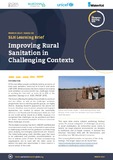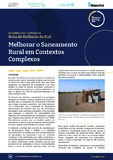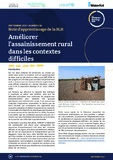Improving Rural Sanitation in Challenging Contexts
Melhorar o Saneamento Rural em Contextos Complexos;
Améliorer l’assainissement rural dans les contextes difficiles
| dc.contributor.author | Tillett, Will | |
| dc.contributor.author | Jones, Oliver | |
| dc.date.accessioned | 2021-03-11T16:08:05Z | |
| dc.date.available | 2021-03-11T16:08:05Z | |
| dc.date.issued | 2021-03-10 | |
| dc.identifier.citation | Jones, O. and Tillett, W. (2021) ‘Improving Rural Sanitation in Challenging Contexts’ Sanitation Learning Hub Learning Brief 8, Brighton: IDS DOI: 10.19088/SLH.2021.006 | en |
| dc.identifier.citation | Jones, O. e Tillett, W. (2021) 'Melhorar o saneamento Rural em Contextos Complexos', Nota de Reflexão do Sanitation Learning Hub Learning Brief No 8, Brighton: IDS. DOI: 10.19088/SLH.2021.020 | pt |
| dc.identifier.citation | Jones, O. et Tillet, W. (2021) « Améliorer l’assainissement rural dans des contextes difficiles » Note d’apprentissage 8 de la SLH, Sanitation Learning Hub, Brighton : IDS. DOI: 10.19088/SLH.2021.021 | |
| dc.identifier.isbn | 978-1-78118-781-4 | |
| dc.identifier.uri | https://opendocs.ids.ac.uk/opendocs/handle/20.500.12413/16465 | |
| dc.description.abstract | Of the two billion people worldwide lacking access to at least basic sanitation, seven out of ten live in rural areas. Progress has been made on increasing rural sanitation and access levels are rising, but barriers remain in reaching the ‘last mile’ or some 10 to 20 per cent of the population who live in the most challenging contexts. The factors affecting the ability of households to construct and use toilets, as well as the challenges sanitation programmes face in reaching specific groups, are highly diverse. Applying one-size fits all approaches has been proven not to work; therefore, we need more nuanced, adapted, and targeted approaches to capture the universality element of the Sustainable Development Goals (SDGs) and ensure that no one is left behind. However, we recognise that challenges can be persistent and there are limited documented examples of how to overcome these challenges at scale. The Sanitation Learning Hub, UNICEF, and WaterAid commissioned this study to map rural sanitation approaches in challenging contexts and the guidance currently being used, drawing out emerging experiences and lessons. It involved key informant interviews (KIIs) with 44 interviewees, and consulting over 180 documented resources. This Learning Brief provides an overview of the study findings. | en |
| dc.description.abstract | Dos dois mil milhões de pessoas que, em todo o mundo, têm falta de acesso a, pelo menos, saneamento básico, sete em cada dez vivem em zonas rurais. Tem-se verificado um aumento do saneamento rural e os níveis de acesso estão a subir, mas continua a haver entraves no que toca a percorrer o «último quilómetro», isto é, chegar aos últimos 10% a 20% da população que vive nos contextos mais difíceis. São muito diversificados os factores que afectam a capacidade dos agregados familiares de construírem e utilizarem casas de banho, bem como os desafios que se colocam aos programas de saneamento no que diz respeito a chegar a determinados grupos. Está provado que não funciona a aplicação de abordagens com uma receita única para todos os casos. Precisamos, pois, de abordagens mais matizadas, mais adaptadas e mais dirigidas para captar o elemento de universalidade dos Objectivos de Desenvolvimento Sustentável (ODS) e garantir que ninguém seja deixado de lado. Reconhecemos, contudo, que os desafios podem persistir e que existem poucos exemplos documentados de como superar estes desafios a uma escala mais ampla. O Sanitation Learning Hub, o UNICEF, e a WaterAid encomendaram este estudo para fazer um levantamento das abordagens de saneamento rural em contextos complexos e as orientações actualmente utilizadas, retirando daí as experiências e as lições que começam a surgir. Este trabalho implicou entrevistas a 44 informadores e a consulta de mais de 180 recursos documentados. Esta Nota de Reflexão dá uma panorâmica geral dos resultados do estudo. | pt |
| dc.description.abstract | Sur les deux milliards de personnes au monde qui vivent sans accès à, au moins, un assainissement de base, sept sur dix vivent en milieu rural. Des progrès ont été faits pour accroître l’assainissement rural et les niveaux d’accès augmentent, toutefois, il reste difficile d’atteindre le « dernier kilomètre » soit les 10 à 20 pour cent de la population qui vivent dans les contextes les plus rudes. Les facteurs qui affectent la capacité des ménages à construire et utiliser des toilettes, ainsi que les difficultés auxquelles sont confrontés les programmes d’assainissement pour atteindre des groupes spécifiques sont extrêmement variés. Il est prouvé que l’adoption d’approches universelles ne donne pas de bons résultats ; par conséquent, il nous faut des approches plus nuancées, adaptées et ciblées pour refléter l’universalité des Objectifs de développement durable (ODD) et faire en sorte que personne ne soit laissé de côté. Toutefois, nous reconnaissons que les difficultés peuvent être persistantes et qu’il n’existe que peu d’exemples documentés sur la manière de les surmonter de manière systématique. La Sanitation Learning Hub, l’UNICEF et WaterAid ont commandité cette étude pour cartographier les approches d’assainissement rural dans des contextes difficiles et les conseils actuellement prodigués, et pour recenser les expériences et enseignements qui s’en dégagent. Elle a englobé des entretiens avec 44 informateurs clés (EIC) et la consultation de plus de 180 ressources documentaires. Cette Note d’apprentissage donne une vue d’ensemble des conclusions de l’étude. | fr |
| dc.description.sponsorship | Sida | en |
| dc.language.iso | en | en |
| dc.publisher | The Sanitation Learning Hub, Institute of Development Studies | en |
| dc.relation.ispartofseries | SLH Learning Brief;8 | |
| dc.rights | This series is licensed under the Creative Commons Attribution-Non-Commercial-NoDerivs 3.0 Unported License (https://creativecommons.org/licenses/by-ncnd/3.0/). Attribution: You must attribute the work in the manner specified by the author or licensor. Non-commercial: You may not use this work for commercial purposes No Derivative Works: You may not alter, transfer, or build on this work. Users are welcome to copy, distribute, display, translate or perform this work without written permission. For any reuse or distribution, you must make clear to others the licence terms of this work. If you use the work, we ask that you reference the SLH website and send a copy of the work or a link to its use online to the following address: Sanitation Learning Hub, Institute of Development Studies, University of Sussex, Brighton, BN1 9RE, UK (SLH@ids.ac.uk). | en |
| dc.rights.uri | http://creativecommons.org/licenses/by-nc-nd/3.0/ | en |
| dc.subject | Rural Development | en |
| dc.title | Improving Rural Sanitation in Challenging Contexts | en |
| dc.title | Melhorar o Saneamento Rural em Contextos Complexos | pt |
| dc.title | Améliorer l’assainissement rural dans les contextes difficiles | fr |
| dc.type | Series paper (IDS) | en |
| dc.rights.holder | The Sanitation Learning Hub | en |
| dc.identifier.team | Participation | en |
| dc.identifier.doi | 10.19088/SLH.2021.006 | |
| dc.identifier.doi | 10.19088/SLH.2021.020 | |
| dc.identifier.doi | 10.19088/SLH.2021.021 | |
| dcterms.dateAccepted | 2021-03-10 | |
| rioxxterms.funder | Default funder | en |
| rioxxterms.identifier.project | The Sanitation Learning Hub | en |
| rioxxterms.version | VoR | en |
| rioxxterms.versionofrecord | 10.19088/SLH.2021.006 | en |
| rioxxterms.funder.project | 5e50f69d-6102-4a66-b12d-49ceb02612b0 | en |
Files in this item
This item appears in the following Collection(s)
Except where otherwise noted, this item's license is described as This series is licensed under the Creative Commons
Attribution-Non-Commercial-NoDerivs 3.0 Unported License
(https://creativecommons.org/licenses/by-ncnd/3.0/).
Attribution: You must attribute the work in
the manner specified by the author or licensor.
Non-commercial: You may not use this work for commercial
purposes No Derivative Works: You may not alter, transfer,
or build on this work.
Users are welcome to copy, distribute, display, translate
or perform this work without written permission. For any
reuse or distribution, you must make clear to others the
licence terms of this work. If you use the work, we ask
that you reference the SLH website and send a copy of
the work or a link to its use online to the following address:
Sanitation Learning Hub, Institute of Development Studies,
University of Sussex, Brighton, BN1 9RE, UK (SLH@ids.ac.uk).




